Advertisement
Why To Exercise Today: Train Now To Shovel More Safely Next Winter
Guest contributor
Over 100 inches of snow fell in the Boston area this past winter, and tons of the heavy, wet stuff had to be shoveled out of driveways and walkways — not just a pain in the neck, but a potential pain in many other parts of the body as well.
Nationwide, an average of 11,500 snow shoveling injuries occur annually, including damage to muscles, ligaments, tendons and other soft tissues. Lower back injuries are the most common.
So what can you do to avoid injury in winters to come if, as some predict, heavy snow becomes more common? To handle the stresses that snow-shoveling places on the body, you need a year-round exercise program. Consult with your doctor before undertaking any exercise program, of course, but here are my starter suggestions:
Begin with a basic total-body strength training program two or three times a week. Improving your strength will make daily routines (such as shoveling) less taxing and help with injury prevention. Strength training is any type of resistance training that includes free-weights, tubing or strength machines. The focus should be on strengthening the legs, hips, shoulders, abs, and lower back.
Basic strength training routine:
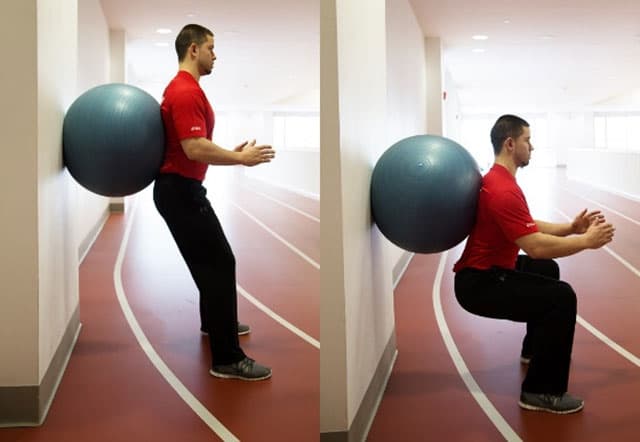
Stability ball squats: You can begin with just your body weight but to increase muscle tension, hold a pair of dumbbells by your side. Placing a stability ball behind your mid-back will engage your abs. Squat down to 90 degrees and keep chest up and hips back. This exercise will help strengthen the legs, hips and abs. Perform two sets, 12 repetitions each.
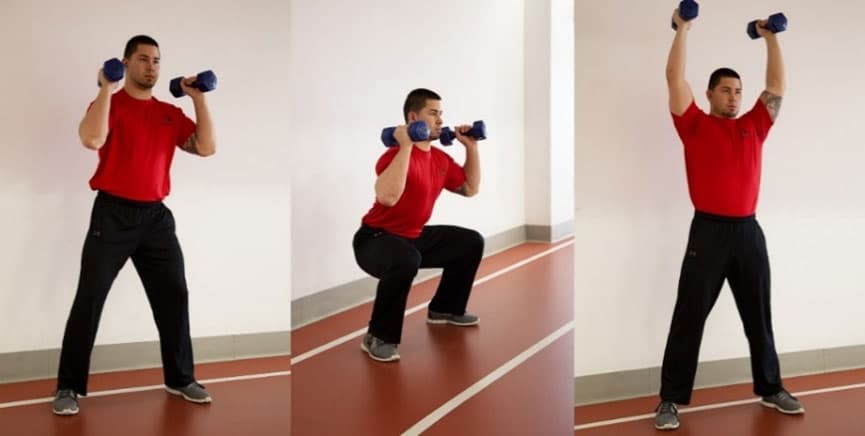
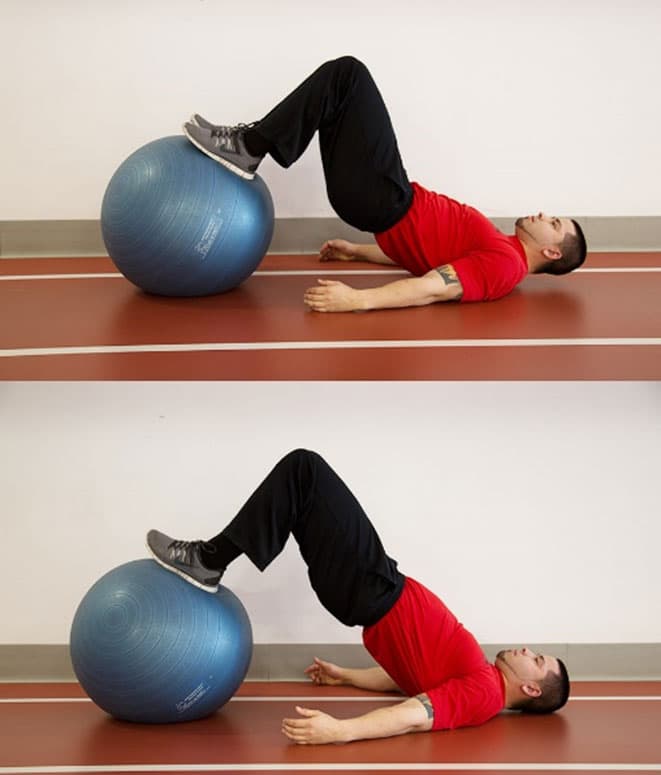
Squat and press: Grab a pair of light dumbbells and hold at shoulder level. Go into a squat position, keeping your chest up and hips back. Once you return to an upright position, tighten your abdominal muscles, and then press a pair of dumbbells overhead. Repeat for 2 sets, 12 reps. This exercise will strengthen your legs, hips, glutes and shoulders.
Hip lifts: This exercise is a great way to work the glutes, hamstrings and the lower back. This exercise can either be done on the stability ball or on the floor. Bend your knees at 90 degrees and place your feet on the ball or floor. Tighten your glutes, push down into the ball or floor with your feet and then lift the hips up until the body is in a straight line. Keep the hands on the floor for more balance if needed. Perform 2 sets of 12-15 reps.
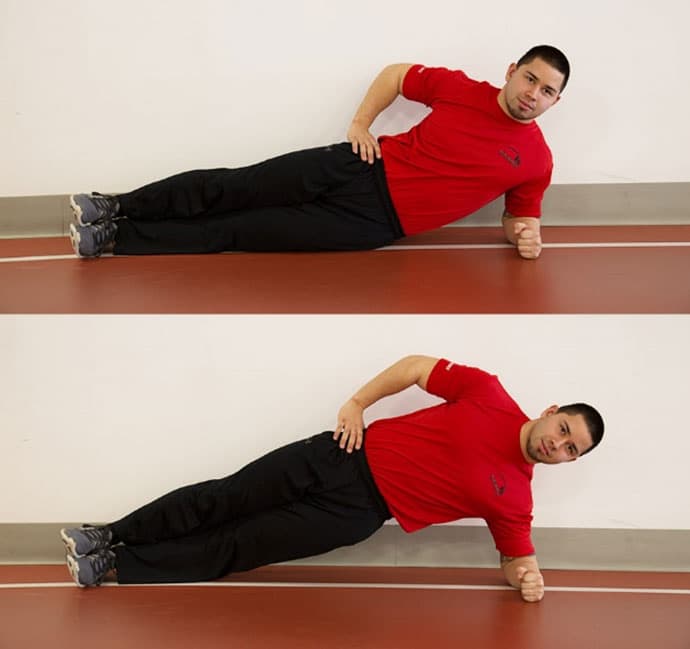
Side planks: Lie on your side with your body straight, one foot on top of the other, your upper arm directly under your shoulder, your hand and forearm placed on the ground and pointing directly in front of you. Push up so that your elbow is bent at 90 degrees and only your left foot, hand and forearm are in contact with the floor. Keep your body tight with your torso, hips and legs in alignment. Hold this position for 30-60 sec, switch sides, and repeat for 2 sets each side. Do not hold your breath. Side planks strengthen the side muscles of your waist.
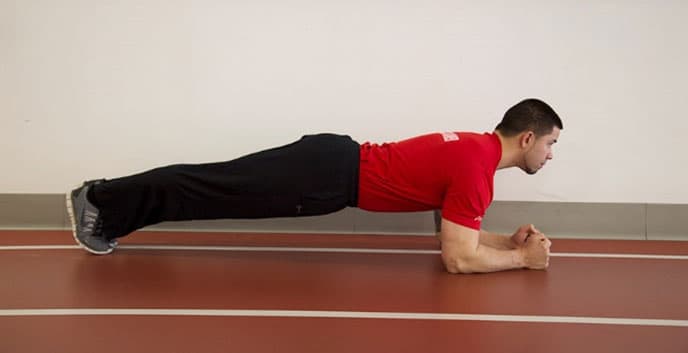
Planks: Start by lying face down on the floor. Place your forearms on the floor with your shoulders aligned directly over your elbows clasping your hands in front of you. Extend your legs behind you and rest on your toes, as if you are going to do a pushup. You should look to attain a straight line between your shoulders and toes. Tighten your abdominal muscles to help you hold the position correctly. Perform two sets for about 30-60 seconds. Do not hold your breath. This is a great exercise to help strengthen your abs.
In addition to beginning an exercise program, you can commit these shoveling tips to memory, to reduce the risk of future injury:
• Use your legs and bend at the knees to lift snow, and avoid excessive twisting and throwing.
• To reduce pressure on your back, try pushing snow to the side instead of lifting snow and throwing it.
• Take frequent breaks so you do not overload your muscles, ligaments and tendons.
• Drink plenty of water to keep hydrated.
• Warm up your muscles before shoveling by stretching your back, legs and shoulders.
• Choose an ergonomically designed shovel that can help reduce the amount of bending you have to do.
• Eat a small snack for energy before you shovel snow, but avoid heavy meals.
• Avoid caffeine or nicotine before beginning. These are stimulants, which may increase your heart rate and cause your blood vessels to constrict. This puts extra stress on the heart.
• Dress appropriately — wear snow boots to avoid slipping, a hat to prevent heat loss, and dress in layers to keep your muscles warm and lessen blood vessel constriction.
Readers, any personal tips to add? And do you have any fitness questions you'd like Rick to address in future posts?
Rick Discipio is the assistant director of fitness at Boston University’s Fitness and Recreation Center, better known as the FitRec. He has experience in training and conditioning athletes, designing post-rehab programs for special populations, and creating employee wellness programs. He's a former competitive powerlifter who won the Mass. State and New England States Bench Press and Powerlifting Championships.